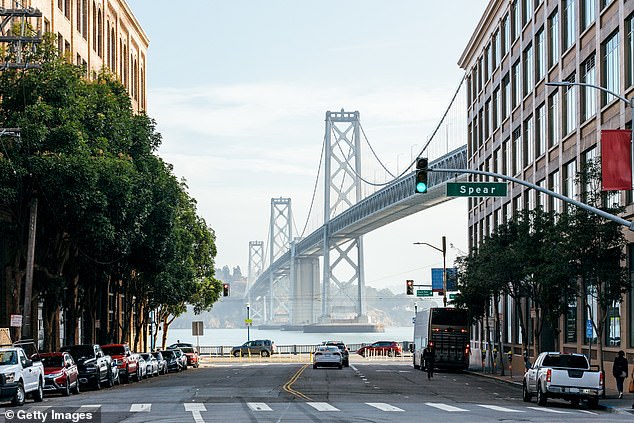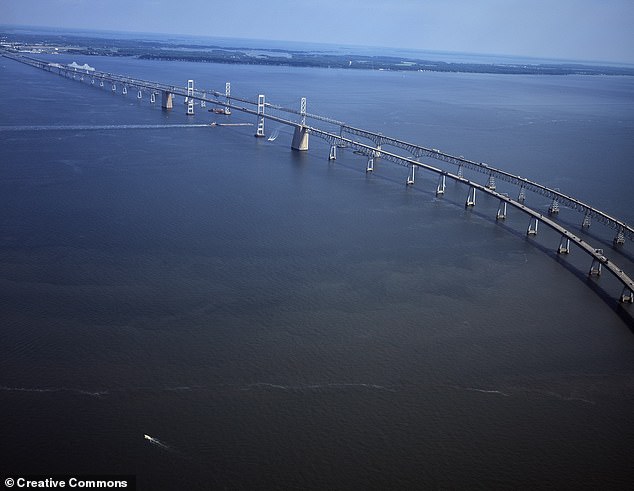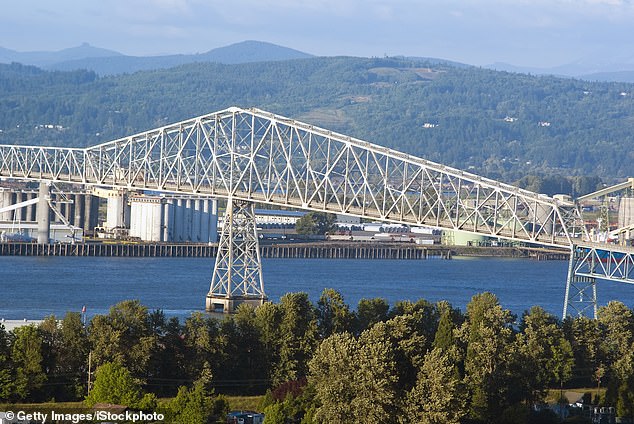The 7 bridges in the US at risk of a Baltimore-like disaster: including the Golden Gate and Verrazzano
There are at least seven bridges in the U.S. with a similar size and scope to the now-collapsed Francis Scott Key Bridge in Baltimore, making them vulnerable to a similar future tragedy, according to the latest federal data.
The Federal Highway Administration’s (FHA) 2023 National Bridge Inventory identified several iconic bridges that contain “fracture-critical members,” meaning damage to just one steel member could cause the entire structure to collapse.
Well-known names like Golden Gate in San Francisco and Verrazzano in New York are on the list, as is the lesser-known St. John’s Bridge in Oregon.
All told, the seven bridges are responsible for the lives of motorists in approximately 794,000 passing vehicles per day.
Even more worrying, these seven bridges are all supported by concrete island towers, or “piers,” which are vulnerable to the kind of ship impact that felled the Key.
But to build bridge piers strong enough to withstand a blow from such a container ship, a senior civil engineer told DailyMail.com last week: “You just end up building a castle in the middle of the river.”
Seven bridges the size and reach of the now-collapsed Francis Scott Key Bridge in Baltimore are vulnerable to a similar future tragedy, according to the latest data from the U.S. Federal Highway Administration. All seven (pictured above) are older than the Key bridge

First completed during the Great Depression, the San Francisco-Oakland Bay Bridge (above) managed to withstand a collision with a container ship in 2007. But this bridge, unlike the Francis Scott Key Bridge in Baltimore, had fenders to absorb the attacks.
Engineer Bilal Ayyub, former chairman of the Infrastructure Resilience Division of the American Society of Civil Engineers, explained that the alternative safety solution is to create barriers that keep ships near a bridge in the first place.
“You cannot design a bridge that can withstand the energy associated with a moving object the size of a ship,” Ayyub told DailyMail.com.
Instead, the former chairman said, engineers construct steel guide rail-like systems called “fenders” around piers, or steer ships away from those crucial piers by dredging artificial “islands” around the structure.
“What they will essentially do is raise the ground (underwater) so that a ship stays on the ground,” he explained. “It’s designed to alert the operator that you know you’re approaching an object.”
While current federal guidelines mandate safeguards like these “fenders.” ‘islands’, or slightly more distant man-made island barriers, also called ‘dolphins’, the seven risk bridges predate these government regulations.
a Wall Street Journal Analysis of the FHA’s National Bridge Inventory found that these seven bridges were comparable in size and construction to the Key to merit comparison.
And many are local and sometimes international icons of their home city.
But inconsistencies have been found in the inventory’s inspection data, which could mean there are other U.S. bridges facing similar risks.

The four-mile Chesapeake Bay Bridge (above), which, like the Key, is in Maryland, is currently being prepared for a multi-billion dollar expansion in anticipation of traffic problems.
The four-mile-long Chesapeake Bay Bridge, which like the Key is in Maryland, is currently being prepared for a multibillion-dollar expansion in anticipation of traffic problems.
The Chesapeake sees approximately 72,000 vehicles crossing daily, per 2016 toll dataand large container ships also pass underneath.
Most of the bridges at risk are in the Pacific Northwest, including the Tacoma Narrows Bridge, Washington; the St. Johns Bridge, Oregon; and the Lewis and Clark Bridge, which connects Oregon to Washington State.
These bridges are also major arteries that pass tens of thousands of vehicles every day: more than 90,000 vehicles for Tacoma Narrows, more than 22,000 vehicles on St. Johns, and approximately 21,400 vehicles travel on the Lewis and Clark.

Every day, approximately 21,400 vehicles cross the Lewis and Clark Bridge (above) between Washington State and Oregon

Every day, the Golden Gate helped an average of 89,000 vehicles cross the strait between the Pacific Ocean and the Bay by 2023, and as many as 10,000 cyclists.
Just further south in the San Francisco Bay Area, two more arterial roads, including the iconic Golden Gate Bridge, meet the size and “pier” design parameters for hazards.
One of them, the San Francisco-Oakland Bay Bridge, is responsible for supporting as many as 280,000 to 300,000 commuter vehicles per day, or more than 13,000 cars during a rush hour.
The San Francisco-Oakland Bay Bridge was first completed during the Great Depression in November 1936 and actually succeeded withstand a collision with a container ship in 2007.
But despite its age, that bridge was equipped with fenders to absorb the impacts.
Similarly, the Golden Gate Bridge has also been reinforced with “the most robust protection system of any bridge on the West Coast,” according to a spokesperson for the state agency that manages the structure. SFGoes last month.
The Golden Gate helped an average of 89,000 vehicles cross the strait between the Pacific Ocean and the Bay every day by 2023, and as many as 10,000 cyclists.
But as experts noted, Baltimore’s Key Bridge had passed all inspections — a strong indication that giant ships like the 1,000-foot-long, 95,000-ton Dali, which destroyed the Key on March 26, might even be an “up-to-date” could sink code’ ship. bridge.
The Verrazzano-Narrows Bridge in New York City was the seventh of the major at-risk bridges identified in the Journal’s analysis.
The structure, which connects the boroughs of Brooklyn and Staten Island, handles an average of about 200,000 vehicles every day. the parks department.
